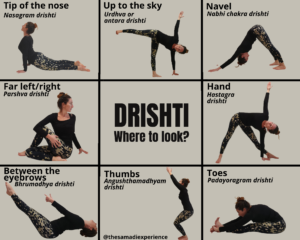As human beings, we are predominantly visual creatures. We connect to the world around us mainly through the sense of sight. Over 50% of our brain is involved with processing visual stimuli. Where our eyes are directed, our attention follows and the visible world can be overstimulating, addictive and even debilitating (think of the hours spent mindlessly scrolling Instagram for example!). When we are caught up in the outer appearance of things, our energy (prana) flows out of us. And in our sensory-overload society, we can easily feel drained.
By controlling and directing the focus, first of the eyes and then of the attention, we are using the yogic technique called DRISHTI. In Sanskrit, the word drishti means sight or seeing, vision, aim or attention. And in the context of yoga, it’s about focusing the gaze on one specific point in order to move the attention of the mind inwards. It’s a way of developing focused intention through the sense of sight.
This method of concentrated gaze supports the Patanjali’s Eight Limbs of Yoga by linking the fifth limb, pratyahara – withdrawal of the senses, with the sixth limb, dharana – concentration. And the use of drishti during the asana practice (physical postures) serves both as a training technique and as a metaphor for focusing the consciousness toward a vision of oneness.
Using Drishti On the Mat
Drishti has always been a core concept of traditional yogic practices but it was popularised by the Ashtanga yoga of Sri K. Pattabhi Jois. Nowadays, we hear about drishti in most yoga classes in the West, usually as an instruction on where to place the focus of the eyes. In every asana, the prescribed drishti assists concentration, aids movement, calms the nervous system and helps orient the pranic (energetic) body. They’re as followed:
-
Nasagram drishti – tip of the nose / e.g. upward-facing dog
-
Bhrumadhya drishti – between the eyebrows / e.g. fish pose
-
Nabhi chakra drishti – navel / e.g. downward-facing dog
-
Hastagra drishti – hand / e.g. triangle
-
Padayoragram drishti – toes / e.g. seated forward folds
-
Angushthamadhyam drishti – thumbs / e.g. chair pose
-
Urdhva or antara drishti –up to the sky / e.g. balancing half moon
-
Parshva drishti – far to the right or far to the left (counted as two) / e.g. seated spinal twists

A steady, intentional gaze provokes the same steadiness in the body. where the focus of the eyes goes, the energy of the body follows. But you should never force yourself to gaze in a way that strains your eyes, brain or body. Use a soft gaze. We want to see the one point but also be aware of the periphery so we can be open and receptive to life.
Like all yogic practices, drishti uses the human body and mind as a starting place for connecting to our full potential, for setting our own intention as a yogi and incorporating that aim into everything we do. It has possibilities for keeping us true to our aims on and off the mat. If love is your intention, drishti on the mat might mean not pushing yourself past your edges or taking Child’s pose during the class. Off the mat, it also means aligning your actions with your higher vision: at home, during conversations with others and even the ones you have with yourself. By turning the gaze inward, we use the mind’s eye to see the experience within.
It is based on where we look and more importantly how we look, guiding us toward a deeper awareness of what is that we are “seeing”.
Drishti Off the Mat
By concentrating our focus to see clearly HOW we see, not only what we see, we can start becoming aware of how our brains only let us see what we want to see. We can start realizing how much our world view is often clouded by our opinions, memories, prejudices, habits and thoughts. Drishti allows us to see through judgments and illusions. The practice of drishti, which involves an understanding of yoga’s ethical precepts, helps clear our vision of the covering of ideas and their projections about what is real and what is false. It teaches us to see the world as it really is by gazing beyond outer appearance and differences to inner essence, consciousness and unity.
By applying drishti on the mat, we become better able to integrate this practice and the wisdom gained into each moment of our lives.
